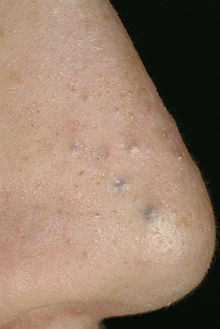- Hidrozytom
-
Klassifikation nach ICD-10 L74.8 Sonstige Krankheiten der ekkrinen Schweißdrüsen L75.8 Sonstige Krankheiten der apokrinen Schweißdrüsen. ICD-10 online (WHO-Version 2011) Ein Hidrozytom (engl. hydrocytoma; ICD-O 8404/0) ist eine gutartige Gewebeneubildung (Neoplasie) aus der Familie der Adenome. Es handelt sich um zystische Papeln des Schweißdrüsenausführungsgangs (Retentionszysten).[2]
Je nachdem welche Schweißdrüse davon betroffen sind, unterscheidet man in ekkrines Hidrozytom (auch Schweißdrüsenretentionszyste genannt) oder apokrines Hidrozytom (auch apokrines Zystadenom genannt).[3][1] Diese Einteilung ist zwar durch neuere immunhistologische Untersuchungen widerlegt, da einige ekkrine Hidrozystome apokrine Antigene exprimieren, hat aber aus historischen Gründen weiterhin Gültigkeit.[4]
Inhaltsverzeichnis
Beschreibung und Diagnose
Hidrozytome kennzeichnen sich durch lichtdurchlässige bläuliche Knötchen, die meist einzeln (solitär) auftreten. Die blaue Farbe entsteht dabei durch den Tyndall-Effekt. Histopathologisch erkennt man uni- oder multilokuläre zystische Bereiche innerhalb der Dermis. Multiple Hidrozytome treten beim Schöpf-Schulz-Passarge-Syndrom, einer seltenen autosomal-rezessiven Genodermatose, auf.[5]
Ekkrine Hidrozytome sind häufig am Augenlid oder den Wangen lokalisiert.[2]
Therapie
Die Entfernung eines Hidrozytoms kann aus kosmetischen Gründen oder bei funktionell störenden Zysten angezeigt sein.[2] Verschiedene Formen der Behandlung von Hidrozytomen sind beschrieben. Neben der einfachen Exzision[6] sind dies die Hochfrequenzchirurgie,[7] die Bestrahlung mit Infrarotlasern (CO2-Laser[8][9] oder 1450-Nanometer-Diodenlaser[10] ) und Trichloressigsäure[11].[1]
Weiterführende Literatur
- S. B. Verma: Multiple apocrine hidrocystomas: a confusing clinical diagnosis. In: Anais brasileiros de dermatologia Band 85, Nummer 2, April 2010, S. 260–263, ISSN 1806-4841. PMID 20520948. (Review).
- H. M. Gilchrist, M. R. Wick, J. W. Patterson: Liesegang rings in an apocrine hidrocystoma: a case report and review of literature. In: Journal of cutaneous pathology Band 37, Nummer 10, Oktober 2010, S. 1064–1066, ISSN 1600-0560. doi:10.1111/j.1600-0560.2010.01559.x. PMID 20492082. (Review).
- K. Sarabi, A. Khachemoune: Hidrocystomas–a brief review. In: MedGenMed : Medscape general medicine Band 8, Nummer 3, 2006, S. 57, ISSN 1531-0132. PMID 17406184. PMC 178130. (Review).
- S. Anzai, M. Goto, S. Fujiwara, T. Da: Apocrine hidrocystoma: a case report and analysis of 167 Japanese cases. In: International journal of dermatology Band 44, Nummer 8, August 2005, S. 702–703, ISSN 0011-9059. doi:10.1111/j.1365-4632.2005.02512.x. PMID 16101883. (Review).
- A. Alfadley, K. Al Aboud, A. Tulba, M. M. Mourad: Multiple eccrine hidrocystomas of the face. In: International journal of dermatology Band 40, Nummer 2, Februar 2001, S. 125–129, ISSN 0011-9059. PMID 11328394. (Review).
- E. Alessi, R. Gianotti, A. Coggi: Multiple apocrine hidrocystomas of the eyelids. In: The British journal of dermatology Band 137, Nummer 4, Oktober 1997, S. 642–645, ISSN 0007-0963. PMID 9390347. (Review).
- R. Betti, E. Inselvini, M. Palvarini, C. Crosti: Beidseitig auftretende apokrine Hidrozystome der Augenlider. In: Der Hautarzt; Zeitschrift für Dermatologie, Venerologie, und verwandte Gebiete Band 45, Nummer 8, August 1994, S. 566–568, ISSN 0017-8470. PMID 7960759.
- S. Veraldi, R. Gianotti, S. Pabisch, G. Gasparini: Pigmented apocrine hidrocystoma–a report of two cases and review of the literature. off. In: Clinical and experimental dermatology Band 16, Nummer 1, Januar 1991, S. 18–21, ISSN 0307-6938. PMID 2025927. (Review).
Einzelnachweise
- ↑ a b c M. Sand, D. Sand, C. Thrandorf, V. Paech, P. Altmeyer, F. G. Bechara: Cutaneous lesions of the nose. In: Head & face medicine Band 6, 2010, S. 7, ISSN 1746-160X. doi:10.1186/1746-160X-6-7. PMID 20525327. PMC 290354. (Review im Open Access).
- ↑ a b c P. Altmeyer, K. Hoffmann: Basiswissen Dermatologie. Verlag W3L GmbH, 2005, ISBN 3-937-13795-5, S. 175–176. Eingeschränkte Vorschau in der Google Buchsuche
- ↑ N. Anandasabapathy, A. C. Soldano: Multiple apocrine hidrocystomas. In: Dermatology online journal Band 14, Nummer 5, 2008, S. 12, ISSN 1087-2108. PMID 18627748.
- ↑ P. Altmeyer, M. Bacharach-Buhles: Enzyklopädie der Dermatologie, Venerologie, Allergologie, Umweltmedizin. Springer-Verlag Berlin Heidelberg, 2010, Online-Version
- ↑ E. Schöpf, H. J. Schulz, E. Passarge: Syndrome of cystic eyelids, palmo-plantar keratosis, hypodontia and hypotrichosis as a possible autosomal recessive trait. In: Birth defects original article series Band 7, Nummer 8, Juni 1971, S. 219–221, ISSN 0547-6844. PMID 4281327.
- ↑ J. D. Henderer, M. Tanenbaum: Excision of multiple eyelid apocrine hidrocystomas via an en-bloc lower eyelid blepharoplasty incision. In: Ophthalmic surgery and lasers Band 31, Nummer 2, 2000 Mar-Apr, S. 157–161, ISSN 1082-3069. PMID 10743931.
- ↑ S. Gupta, U. Handa, S. Handa, H. Mohan: The efficacy of electrosurgery and excision in treating patients with multiple apocrine hidrocystomas. In: Dermatologic surgery : official publication for American Society for Dermatologic Surgery [et al.] Band 27, Nummer 4, April 2001, S. 382–384, ISSN 1076-0512. PMID 11298711.
- ↑ J. del Pozo, J. García-Silva, C. Peña-Penabad, E. Fonseca: Multiple apocrine hidrocystomas: treatment with carbon dioxide laser vaporization. In: The Journal of dermatological treatment Band 12, Nummer 2, Juni 2001, S. 97–100, ISSN 0954-6634. doi:10.1080/095466301317085381. PMID 12243666.
- ↑ L. K. Bickley, D. J. Goldberg, S. Imaeda, W. C. Lambert, R. A. Schwartz: Treatment of multiple apocrine hidrocystomas with the carbon dioxide (CO2) laser. In: The Journal of dermatologic surgery and oncology Band 15, Nummer 6, Juni 1989, S. 599–602, ISSN 0148-0812. PMID 2723224.
- ↑ A. V. Echague, S. Astner, A. A. Chen, R. R. Anderson: Multiple apocrine hidrocystoma of the face treated with a 1450-nm diode laser. In: Archives of dermatology Band 141, Nummer 11, November 2005, S. 1365–1367, ISSN 0003-987X. doi:10.1001/archderm.141.11.1365. PMID 16301382.
- ↑ R. A. Dailey, S. M. Saulny, R. N. Tower: Treatment of multiple apocrine hidrocystomas with trichloroacetic acid. In: Ophthalmic plastic and reconstructive surgery Band 21, Nummer 2, März 2005, S. 148–150, ISSN 0740-9303. PMID 15778671.
Weblinks
Wikimedia Foundation.

